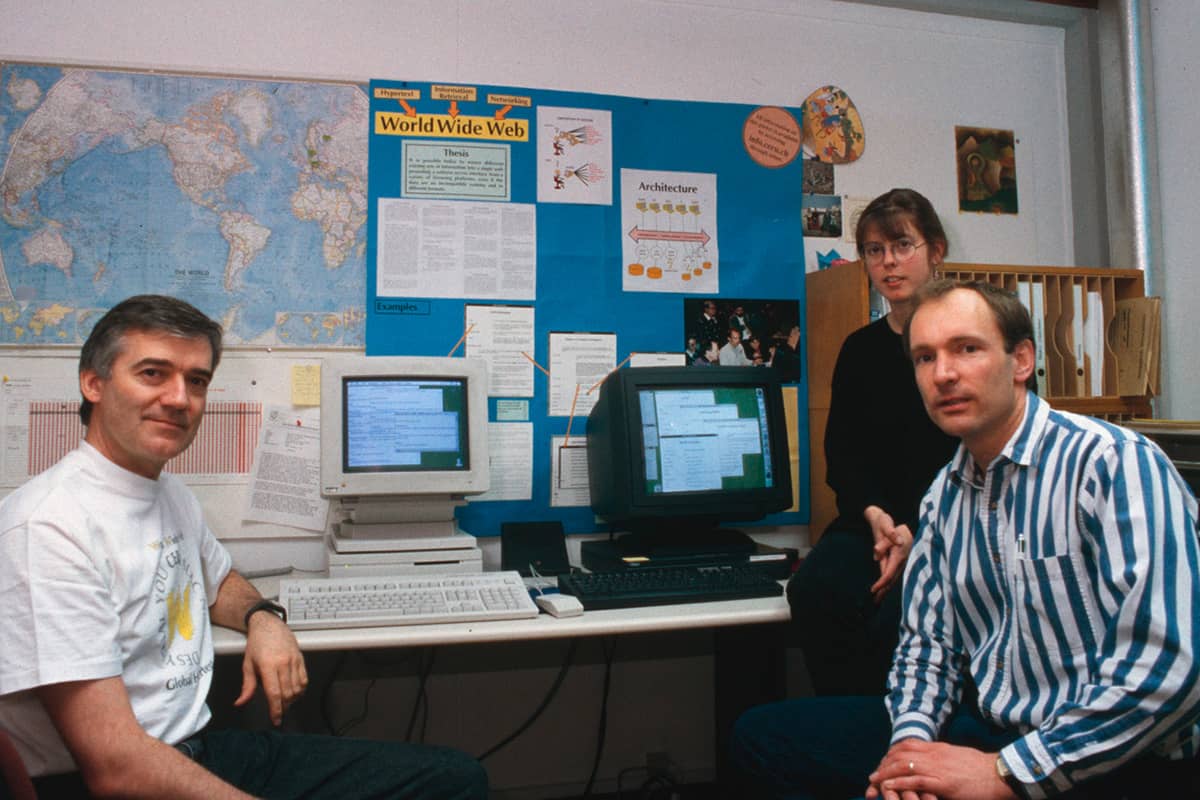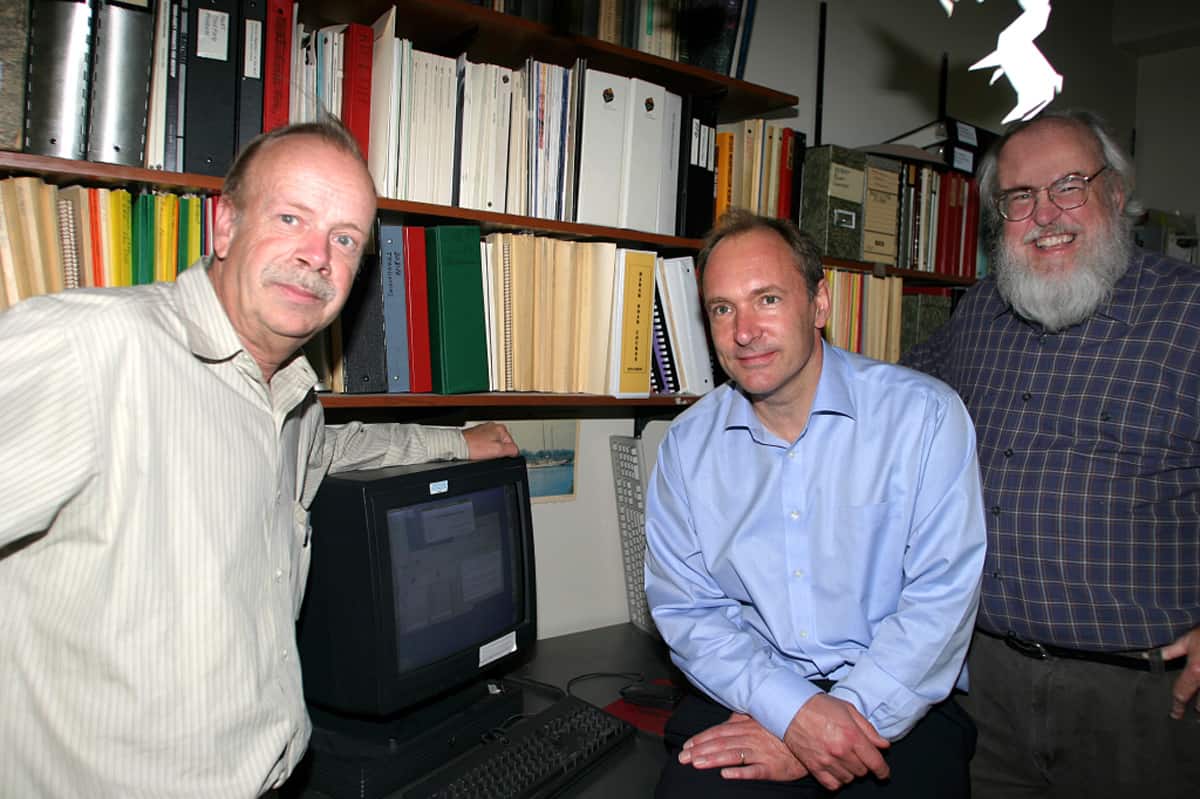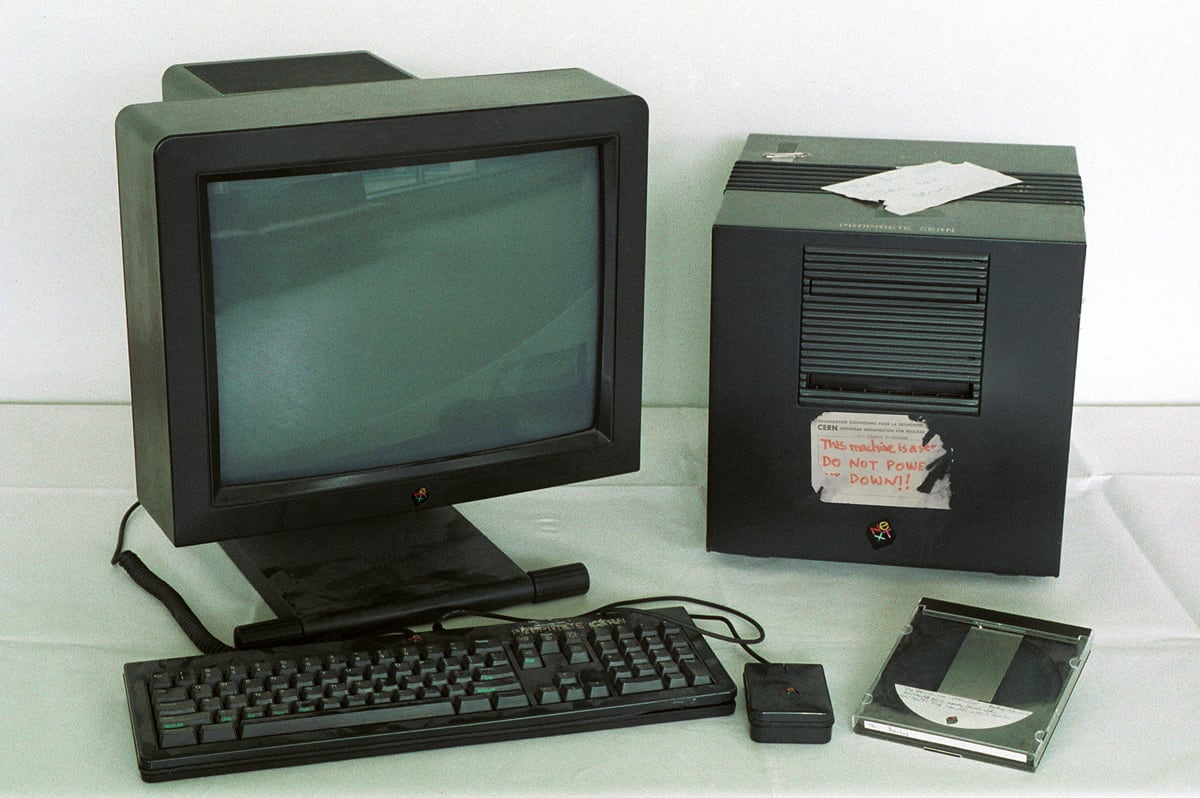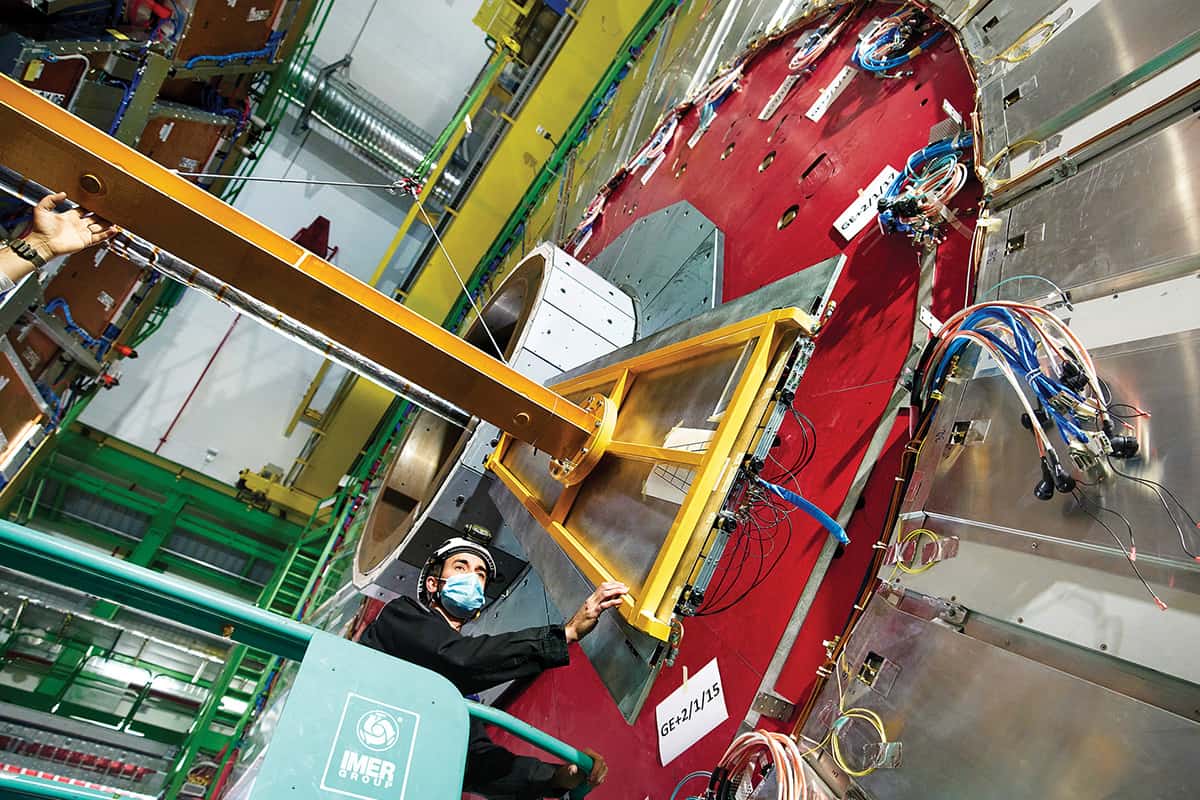Thirty years after the World Wide Web first expanded from Europe to North America, Michael Riordan reveals how physicists and programmers played important roles in shaping the current wave of globalization

In December 1991 Paul Kunz, a physicist and computer programmer at the Stanford Linear Accelerator Center (SLAC) in Menlo Park, California, set up the very first Web server in North America. I learned of it about a month later, upon returning to SLAC from a year in Washington, DC. “Have you seen the latest?” an enthusiastic colleague asked. “It’s called the World Wide Web!”
At the time, I didn’t grasp the tremendous historical significance of that event 30 years ago, which was the point at which the Web truly became a worldwide system. Until that month, it had been a mostly European project focused upon the CERN particle-physics lab near Geneva, developed there by the physicist-turned-programmer Tim Berners-Lee. In 1991 scientists who came to CERN from across the continent had begun using the Web to share documents and data. An early “killer app” was the CERN phone book, which could now be accessed via the Web from different computer platforms at the lab or externally via the Internet.

Electronic publishing and visions of hypertext
The SLAC server now allowed physicists worldwide to access its valuable SPIRES database of particle-physics preprints. Before that, it was challenging for those outside SLAC to log onto this collection of papers. Afterwards, accessing it became easy. Web traffic tripled in the two months after Kunz programmed the SLAC server, making SPIRES the new killer app. “A world of information is now available online from any computer platform,” boasted Berners-Lee in the CERN computer newsletter that December.
Physicists then were largely unaware of its likely impact, but a major rupture in world history transpired late that month. Meeting in Moscow on 26 December 1991, the Supreme Soviet dissolved the Union of Soviet Socialist Republics. The bipolar world order of the Cold War officially ended, to be replaced by one in which democratic Westernized nations predominated, knitted together increasingly by the Internet and Web.
As British historian Eric Hobsbawm observed in his epochal 20th-century history The Age of Extremes: “There can be no serious doubt that in the late 1980s and early 1990s an era in world history ended and a new one began.” Physicists and programmers – especially at CERN and SLAC – were to play pivotal roles in shaping the technological foundations of the emerging world order.
Spreading the Internet
The origins of the Internet trace back to the ARPANET, developed by the US Department of Defense’s Advanced Research Projects Agency during the depths of the Cold War. In the 1980s a variety of computer networks such as the National Science Foundation’s NSFNET appeared in the US. By adopting ARPANET’s software protocols, these networks permitted computers to communicate across one another and led to the “network of networks” or Internet.
CERN, which opened connections to the Internet in January 1989, proved the ideal site for the Web to germinate. During the 1980s hundreds of physicists had been arriving from all over Europe – increasingly from Eastern Bloc nations – as well as from the US to do research on the Large Electron Positron (LEP) collider and its associated detectors. They brought with them a variety of personal computers that communicated with one another over diverse networks set up by the various experimental collaborations.



This environment provided fertile soil for the development of the Web by Berners-Lee and Belgian software engineer Robert Cailliau, between 1989 and 1990. Using a powerful NeXT computer featuring a point-and-click graphical user interface, Berners-Lee programmed the initial Web software in the autumn of 1990. He began communicating via the Internet with Cailliau’s NeXT machine just before Christmas of that year.
“By 1990 CERN had become the largest Internet site in Europe,” recalled CERN network czar Ben Segal in an online article in 1995. “[The lab] positively influenced the acceptance and spread of Internet techniques both in Europe and elsewhere.” Indeed, the Web was soon a primary reason for scientists to access the Internet.
In August 1990 nuclear and particle physicists in Russia established Internet links via phone lines to Finland. And seven months later, it became accessible in Hungary, Poland and the former Czechoslovakia after the NSFNET was extended to these Eastern Bloc nations. In both networking and software, physicists at CERN led Europe onto the emerging “information superhighway”.
California bound
In September 1991 Kunz was passing through CERN on his return to SLAC from Sweden and met up in Geneva with Berners-Lee, who showed him the Web. He quickly grasped its potential after seeing how he could use it to communicate over the Internet with his NeXT workstation back at SLAC. “I was really excited,” he recalled in James Gillies and Cailliau’s 2000 book How the Web Was Born. “I told Tim I was going to put SLAC’s SPIRES database on the Web as soon as I got home.”
After returning, Kunz visited SLAC librarian Louise Addis. “I’ve just been at CERN and found this wonderful thing a guy named Tim Berners-Lee is developing,” he told her. “It’s called the World Wide Web, and it’s just the ticket for what you guys need for your database.” But it took more than two months to set it up, partly because Kunz had delegated the work establishing it on SLAC’s mainframe computer to programmer Terry Hung.
Addis and Berners-Lee therefore pressed Kunz back into service to finish the task. On Thursday 12 December 1991 the first Web server outside of Europe (slacvm.slac.stanford.edu) went online, making SPIRES available throughout the world. Hardly 24 hours later, Berners-Lee announced its existence on the WWW interest-group bulletin board: “There is an experimental W3 server for the SPIRES high-energy physics preprint database thanks to Terry Hung, Paul Kunz and Louise Addis at SLAC.”
By the following summer, three more high-energy physics labs had set up Web servers: Fermilab in the US, DESY in Germany and the National Institute for Subatomic Physics (NIKHEF) in the Netherlands. Meanwhile, the Laboratory for Computer Science at Massachusetts Institute of Technology, which Berners-Lee visited that summer, established a server that June. Others soon followed, as he and Cailliau hit the lecture circuit to promote their new networking system.
A key event was the 1992 Computing in High-Energy Physics Conference at Annecy, France, that September. Cailliau and Berners-Lee gave Web demonstrations and a prominent lecture entitled “World Wide Web”, displaying a map showing the growing number of Web servers in Europe and North America, plus others planned for Asia and Australia – about 20 in all. Their presentation was the principal highlight of the conference for Terry Schalk, a particle physicist from the University of California, Santa Cruz, who in summarizing the meeting to delegates, remarked that “if there is one thing everyone should carry away with them from the conference, it is the World Wide Web”.
By November 1992 there were at least 26 Web servers worldwide, most of them at high-energy and nuclear physics labs in Europe and the US. But what was needed for the Web to gain much wider acceptance were software “browsers” that worked on the personal computers then commonly in use. Cailliau and CERN intern Nicola Pellow had been programming an Apple Macintosh browser on and off for nearly a year, and a group of students there was developing an IBM PC browser. But their efforts suffered from a lack of management support.
And so CERN outsiders ended up developing the first widely useful browsers, mostly at SLAC and the University of California, Berkeley. They included the British high-energy physicist Tony Johnson – a member of an informal group dubbed the “SLAC WWW Wizards” – who in the autumn of 1992 was developing a browser called Midas (or MidasWWW) for computers with Unix operating systems. Like the browser that Berners-Lee had programmed for his NeXT workstation, it displayed graphic images in separate windows. Midas was becoming popular at SLAC, but Johnson was reluctant to make it widely available, given the amount of his time that would require.

In mid-November, however, Johnson released the browser on the FreeHEP website, announcing it on the www-talk newsgroup. Among the first to try the software was Marc Andreessen, a computer-science undergraduate at the University of Illinois. He became enamoured of the Web that month while working at the National Center for Supercomputing Applications (NCSA) on campus, developing computer-visualization software. Andreessen e-mailed Johnson about it the very next day. “MidasWWW is superb!” he exclaimed. “Fantastic! Stunning! Impressive as hell!”
He suggested they collaborate on an improved version incorporating colourful graphic images and animations. Intrigued at first, Johnson turned down the offer after considering how such an intensive programming activity would conflict with his physicist day job. Instead, Andreessen teamed up with NCSA staff member Eric Bina to develop a browser for Unix-based computers. After a feverish two months of programming activity, including many pizza-fuelled all-nighters, they released what they dubbed NCSA X Mosaic 0.5 in January 1993. “Brilliant!” Berners-Lee exclaimed after seeing it. “Having the thing self-contained in one file makes life a lot easier.”
Whereas earlier Web pages were dominated by text, they could now resemble glossy magazine pages
Over the next two months, Andreessen and Bina released six more versions of X Mosaic in rapid succession. By early March, their browser could include embedded graphics on computer screens for the first time – rather than having to open a separate window to view them. Whereas earlier Web pages were dominated by text, they could now resemble glossy magazine pages.
That April NCSA officially released its X Mosaic software. But the Unix-based computers on which it functioned were largely the domain of the academic community, or government and industrial laboratories. If the Web were ever to be commercialized, companies and ordinary users needed browsers that worked on Macintosh and IBM personal computers. These were being developed by other programmers at NCSA, and were released in September 1993. Easy to install and with superior graphics capabilities, they were soon being downloaded for free by thousands of personal-computer users every month. (Now I could access the Web from my PowerMac computer, not just on the SLAC mainframe.)
Together, the Mosaic browsers and the Web provided a means for the rapidly growing legions of personal-computer users to access the information superhighway. And with such a burgeoning audience now available, the number of websites exploded. “By 1994 the centre of gravity of the World Wide Web had crossed the Atlantic to a place where the entrepreneurial heart beats stronger,” recalled Cailliau and Gillies in 2000. Specifically, it had moved to Silicon Valley, especially after Andreessen headed there early that year to co-found Netscape Communications and to develop Netscape Navigator, which soon replaced Mosaic as the most popular Web browser.
Worldwide collaboration
High-energy physics had another important contribution to make that year – extending the Internet and Web into China. Before 1994, that awakening giant had international telephone connections with the outside world but no Internet-capable linkage. SLAC physicist Les Cottrell had been trying to remedy the problem, working with computing staff at the Institute of High Energy Physics (IHEP) in Beijing. They finally established a satellite link from SLAC to Beijing Airport, with microwave links and copper landlines relaying signals between the airport and IHEP. On 17 May 1994 the first Internet link to China began operating. Hundreds of Chinese scientists, including those doing research at CERN, could now access the Web via links to IHEP.
That December, the CERN Council decided to proceed with construction of the Large Hadron Collider project, which would transform the laboratory from a European facility into a world centre for high-energy physics. The LHC project would eventually cost nearly €10bn and involve physicists from all over the world – including China, Eastern Europe, Japan, India, Russia and the US. It included the installation of more than 1800 superconducting magnets in the existing LEP tunnel and construction of gargantuan particle detectors at four locations around the 27 km ring.
It is difficult to imagine how the Large Hadron Collider could ever have succeeded without intensive use of the Internet and Web
It is difficult to imagine how this enormous, technologically sophisticated project could ever have succeeded without intensive use of the Internet and Web. And the recent extension of the Internet into Eastern Bloc countries and China allowed their scientists to become equal partners in this globe-spanning enterprise. In fact, the LHC pioneered many of the information-sharing techniques that have since come to characterize the globalized world that emerged after the Cold War ended.
Typical of the international organizations focused on CERN were the huge scientific collaborations that began designing and building the four collider detectors. Here I mention only one of them, the Compact Muon Solenoid (CMS) collaboration, but there are many similarities with the other three. Led at first by CERN physicist Michel Della Negra, it initially involved large contingents from Finland, France, Germany, Italy and Russia – and eventually China and the US too. Of the 1243 scientists listed on its December 1994 technical proposal, there were 236 from nations of the former Soviet Union and 36 from China. Organizing and managing such a sprawling international collaboration would have been nearly impossible without something like the Web to keep members informed of the status of their project.

The Web also permitted individual members to post documents on the CMS website (cms.cern.ch) and get rapid feedback from other members. Managers could seek out and resolve design conflicts before they became serious. As these efforts occurred across three continents and 18 time zones, the Web allowed scientists to coordinate their actions and beliefs at an unprecedented global scale.
The Web proved important, too, in designing and building the collider itself. This really hit home for me in June 2000 when I interviewed LHC project director Lyn Evans at CERN while researching the history of the Superconducting Super Collider (SSC) – the US facility that had been cancelled in October 1993. In his office he showed me a large table-top computer display of the collider project. Using it, Evans could monitor and coordinate many elements of this sophisticated project at a finger’s touch – for example, the superconducting magnet cores then being manufactured by French, German and Italian companies.
Data on testing and performance did not have to await the delivery of paper reports or e-mail attachments; they were immediately available online. Evans could tell quickly whether critical components were encountering problems and devote resources to remedying them. Keeping components on schedule is crucial in project management, for delays in one area can affect many others and lead to large cost overruns. The Web helped high-energy physics to successfully surmount the multibillion-euro scale of accelerator projects – at which level the SSC project had fallen through.
Electronic supply chains
In the early 2000s the Web’s impact began to be felt in industry, too, as management gurus and business schools began preaching the values of “electronic supply-chain management” (e-SCM). Involving intensive use of the Internet and Web to coordinate manufacturing, marketing and sales activities, e-SCM was doubtlessly inspired to some extent by physicists’ uses of the Web in the LHC project. But SCM was hardly a new idea. It derived in part from the management philosophy of “just-in-time” or “lean” manufacturing pioneered by Japanese corporations. These early supply chains typically involved other Japanese firms, making coordination achievable using local computer networks or telephones.
With the advent of the Internet and Web, supply chains could be extended globally to take advantage of cheap labour supplies in developing nations such as China, Mexico and Vietnam. By allowing detailed design and other information to be shared among selected manufacturers and by enabling rapid data and financial exchanges, the Web also permitted supply chains to expand across continents. The Internet and Web made it much easier to outsource labour-intensive activities while maintaining quality control and concentrating on core competencies, thus reducing costs. It is difficult to imagine such a global commercial transformation happening without the ultra-dense, fine-grained information transfers that occur at light speed almost every second over the Internet.

But while these global exchanges have benefitted financial and technological elites, and the corporations that employ them, they helped to export low-skilled labour, taking it from blue-collar workers in developed nations and exacerbating existing inequalities. In the semiconductor industry, for example, there is a set of low-skilled, labour-intensive functions in the production of microelectronic circuits called “assembly, test and package”. These functions were performed initially in such places as Allentown, Pennsylvania, and Mountain View, California. But semiconductor firms have largely offshored this category of work to China, while keeping high-value-added, highly paid functions such as microchip design at home in Silicon Valley or Austin, Texas.
After China joined the World Trade Organization (WTO) in 2001, such exports of low-skilled jobs to this nation exploded. A good barometer of China’s economic activity, and indirectly the amount of labour being offshored to it, is its annual energy consumption. In the decade immediately after joining the WTO, this consumption more than doubled from about 12,500 to over 31,000 terawatt hours. So did its annual coal consumption – from less than 1500 to more than 3500 million tonnes – and its total emissions of carbon dioxide. As Swedish political ecologist Andreas Malm observed, China became “the chimney of the world” literally overnight.
Reliable estimates put the resulting loss of US jobs in the millions. A largely unanticipated result has been the hollowing out of Middle America, particularly in the industrial Midwestern states such as Indiana, Michigan and Ohio. Pennsylvania’s Lehigh Valley, home to Allentown – where the Bell Telephone System’s principal microelectronics manufacturing arm had previously been located – is now a major distribution centre in the north-east of the US for dozens of companies from Amazon to Walmart, whose warehouses dot valley farmlands. Few of the goods being distributed there are “made in America” any more. Europe experienced similar blue-collar job losses too.
A world transformed
There can be no serious doubt that the world has been experiencing a vast economic and cultural transformation since the Cold War’s end. Nor can there be much doubt that the Internet and Web played crucial roles in this most recent globalization wave. In the prior wave, occurring during the 19th and early 20th centuries, fossil-fuelled transportation, electricity generation and telephone communication played similar crucial roles – enabling extensive worldwide trade and cultural exchanges among far-flung nations. That wave ended during the First World War and the ensuing bifurcation of the globe into exclusive capitalist and communist spheres of influence.
Other technologies have enabled the present wave of globalization, among them fibre-optic and satellite communications as well as containerized shipping and trucking. But the Internet and Web have played pivotal roles, for without them one cannot begin to imagine the extent of the scientific, commercial and cultural exchanges that have become commonplace.
The benefits from the Web have not, however, come without tremendous wider economic and social dislocations
The obvious benefits that have accrued from the Web since its emergence in the high-energy physics community in the early 1990s have not, however, come without tremendous economic and social dislocations. Those disruptions have afflicted important sectors of the US and other national economies, leading to angry “populist” reactions in Europe and America. Brexit and the 2016 electoral victory of Donald Trump were two conspicuous outcomes of this surge of anti-globalization fervour on opposite sides of the Atlantic.
The world has indeed been transformed by the Web, but not entirely for the better.
© Michael Riordan 2022
- This article is adapted in part from “Digital fire: the origins and impacts of the World Wide Web”, to appear in the forthcoming IOP Publishing ebook Big Science in the 21st Century. The author also discusses the growth of the Web in the 20 January 2022 edition of the Physics World Weekly podcast.



